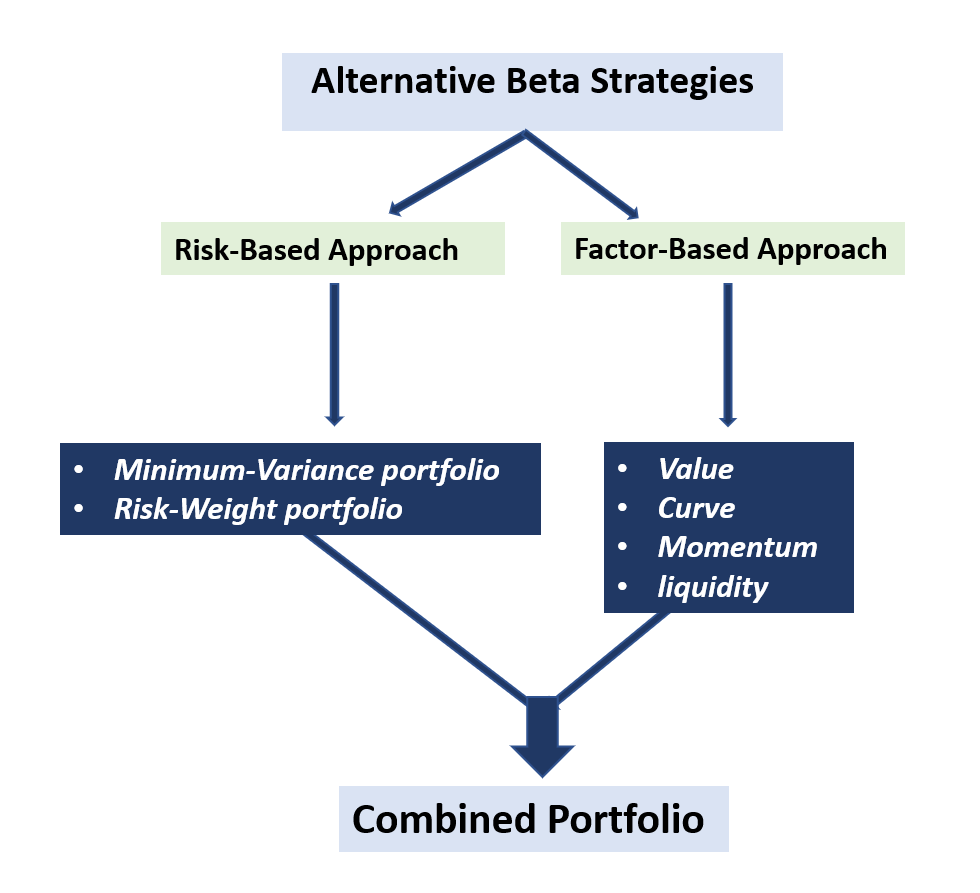Latest news about Bitcoin and all cryptocurrencies. Your daily crypto news habit.

Harry Markowitz’s 1952, modern portfolio theory has been the cornerstones of asset allocation and portfolio construction. In reality, the correlation between traditional asset classes has increased steadily over the past decade. Seemingly unrelated assets moved in lockstep, and portfolios once thought to be diversified did not weather the storm.
This has led to some investors exploring alternative beta strategies as an alternative to conventional market portfolios. Alternative beta strategies area two-fold. One approach is the “risk-based approach” and the other is the “factor-based” approach.
These strategies have become part of equity investing and the popularity of these strategies originate from both a desire for diversification and the awareness that systematic risk factors explain the majority of long-term portfolio returns.
This article explores both risk-based and factor-based alternative beta indices in commodities and assess the merit of combining multiple systematic risk factors, in multi-asset portfolios.
1. Assessing Alternative Beta Strategies
1.1 Risk-Based Approach
Traditional indices, use global production and trading liquidity as primary determinants in assigning weights to sectors and commodities.
Despite the number of sectors S&P GSCI is heavily tilted towards energy (historically highest risk sector). Weighting has reached as high as 60–70%, equating to roughly 80–90% of the total risk in the index. As an example, the smallest 10 components of the 24 commodity components in the index, collectively represent less than 10% of the index.
On the other hand, the Dow-Jones was designed with sector constraints to allow no more than a third of the index to be dominated. However, energy often makes up about 50% of the total risk exposure and often this limit is breached as energy price rise in between annual rebalancings.
There are two common approaches in the risk-based approach — the Risk-Weight portfolio and the Minimum-Variance portfolio.
- The Risk-Weight index attempts to allocate a similar risk budget to each of the five commodity sectors.
- The Minimum-Variance index seeks to minimize the volatility of the index as a whole.
The results show that both above strategies can lower risk.
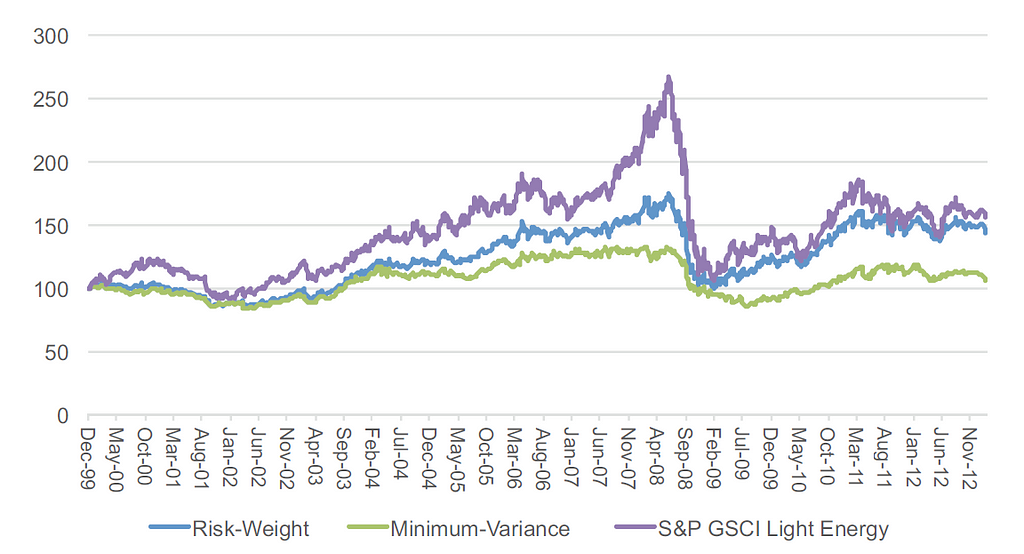 Performance of a Selection of Risk-Based Strategies
Performance of a Selection of Risk-Based Strategies
- Minimum- Variance strategy has achieved the lowest risk amongst all three indices.
- Both risk-based strategies have yielded a lower annualized return than the S&P GSCI Light Energy benchmark. Having less exposure to energy explains this.
The Risk-Weight strategy was superior to the Minimum-Variance when risk and return trade-off was considered. Commodity prices and volatility often go with each other. Hence the distribution of commodity returns tends to be positively skewed.
By merely targeting the lowest level of volatility may be counterintuitive, and a more satisfactory approach would be to target risk reduction by assigning a risk budget across different commodities and sectors.
1.2 Factor-Based Approach
A factor-based approach involves enhancing return by earning risk premium linked to systematic factors. In commodities, the most-well-known factors are Value, Curve, Momentum, and Liquidity.
1.2.1 Value Strategies
Value strategies aim to generate excess returns from commodities that are mispriced aginst their supply-demand dynamics.
- Purchase a portfolio of undervalued commodities, with the expectation that their prices will converge to a higher level.
- In addition to buying cheap commodities, investors sell overvalued commodities.
These strategies target commodities with the lowest inventories. Due to the difficulty in replenishing instantaneously, they will experience price appreciation. Shortages in these commodities take time to be addressed through extra production, demand destruction, or both.
Many theories have been put forward to explicate the relationship between the term structure of the commodity futures markets and physical stock reserves:
- Nicholas Kaldor’s [1939] — the differences between spot and futures prices (or the futures basis) can be ascribed to warehousing costs, interest foregone in storing a commodity and a convenience yield on inventory. When a commodity is seen as scarce, the convenience yield strengthens as there is benefit from holding physical stocks.
- Breeden [1980] and Jagannathan [1985] view futures prices as a forecast of the future spot price and a risk premium. More recently, Gorton, Hayashi, and Rouwenhorst [2007] have provided evidence of the negative, nonlinear relationship between convenience yield and the level of stocks.
The future spot prices will also strengthen as there is more interest in hedging against future price risk.
When the market anticipates a supply shortage, the prices of the futures contracts across maturities increase, creating an upward, parallel shift of the entire futures curve.
A number of indexes have been launched in recent years to harvest this ‘risk premium’. They involve equal weighting small number of commodities selected based on their perceived scarcity. Whilst they have overall delivered strong returns, their exposure tends to be fairly concentrated, owing to the small number of commodities included in the index.
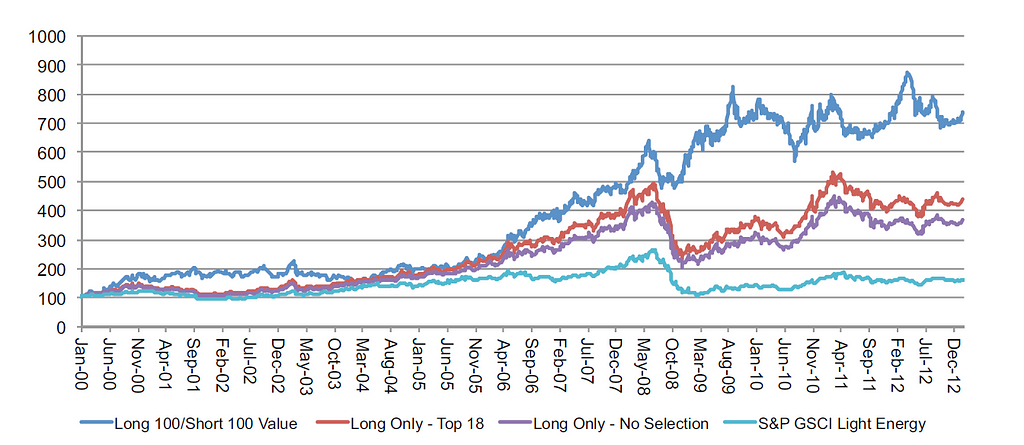 Performance of a Selection of Value Strategies
Performance of a Selection of Value Strategies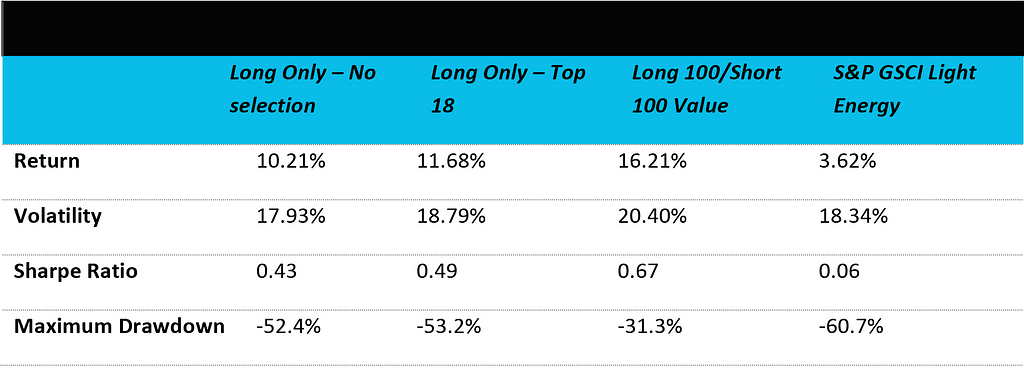 Value Strategies: Historical Annualized Risk and Return
Value Strategies: Historical Annualized Risk and Return
A study conducted by Daniel Ung and Xiaowei Kang shows that value strategies have performed well over the period under investigation, with all of them achieving a higher Sharpe ratio than their benchmark.
It should be pointed out that a simple change in the weighting scheme applied allows good benefits, whilst at a lower risk.
Active selection by eliminating the most overvalued commodities are also advantageous.
The long 100/short 100 version has achieved the best return overall. However, this enhanced also assumes higher active risks.
All three strategies have suffered lower maximum drawdowns than the benchmark.
1.2.2 Curve Strategies
Indices are often long only passive indices that roll their front-month futures position on a regular basis to maintain exposure to commodities.
During periods of backwardation, the positive carry can be earned through the simultaneous sale of a more expensive expiring contract and the purchase of a cheaper subsequent contract.
During periods of contango, investors suffer from negative carry, which erodes their overall return. For some time, the futures curves of many commodities have been in contango. This has led to the development of a variety of curve strategies that attempt to mitigate the negative effect of this term structure by rolling into contracts with a longer maturity.
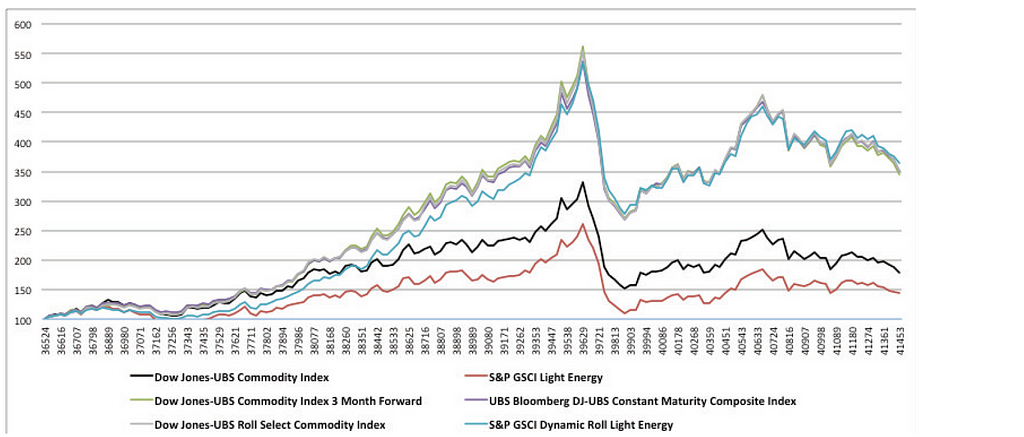 Performance of a Selection of Curve Strategies
Performance of a Selection of Curve Strategies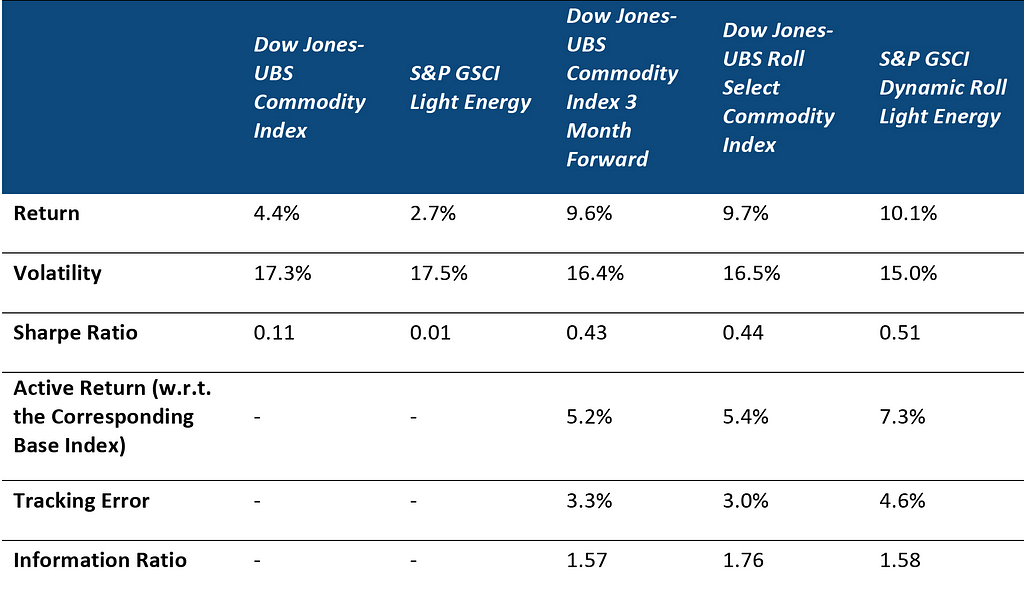 Curve Strategies: Historical Annualized Risk and Return
Curve Strategies: Historical Annualized Risk and Return
In theory, commodity producers sell long-dated contracts at a discount in order to hedge their output, whereas consumers often buy short-dated contracts at a premium in order to secure near-time consumption.
The simplest implementation of curve strategies involves systematically rolling into forward contracts of a predefined maturity, such as the three-month contract.
Another way of implementing the curve strategy is to invest in contracts of different tenors.
 Performance Attribution of Curve Strategies
Performance Attribution of Curve Strategies
Even more dynamic strategies — such as the S&P GSCI Dynamic Roll and the Dow Jones-UBS Roll Select indices — have also garnered much interest in recent years.
Over the long term, all four curve-strategies have delivered higher returns than their respective benchmarks.
1.2.3 Momentum Strategies
Momentum strategies aim to exploit the persistence in commodity returns, arising from psychological biases of investors and industrial market participants.
Besides investor psychology, the behaviour of industrial market participants may also bring about price trends. Taking Kansas wheat as an example, consumer demand remains fairly stable throughout the year whilst production can vary immensely, as planting usually begins in September of the previous year. If during harvest in June and July there is a sudden surge in demand, and this is not satisfied by imports, prices will inevitably go up, giving rise to positive price momentum.
Momentum strategies can be implemented in a variety of ways. In general, they take both long and short positions and consist of at least two steps:
- Determine what position to take for each commodity.
- Decide on an appropriate weighting scheme.
An example of a simple momentum strategy is the Morningstar Long/Short Commodity Index, which uses a simple moving average signal to determine the trading position of each commodity, which is then weighted by the open interest of its futures.
The S&P Systematic Global Macro Commodities Index establishes the trend of each commodity and statistically verifies the stability of the trend. It then gives equal risk capital allowance to each sector and then equal weight to the constituents within that sector.
In range-bound markets with no clear trend, they are unlikely to generate returns. This highlights the danger of relying on a single strategy for an investment portfolio.
1.2.4 Liquidity Strategies
An important characteristic of these first-generation indices is that they roll over a similar window. For instance, the S&P GSCI rolls over five days between the fifth and ninth business day, whereas the Dow Jones- UBS Index rolls between the sixth and tenth.
As a result, sizable investment flows go into simultaneously selling the front-month and purchasing the following nearby month contracts giving rise to a liquidity premium that can be harvested.
However, as more innovative indices came to market, this benefit is dissipating and the return from these strategies are decreasing.
Hence, liquidity is by far the smallest source of return, compared to the other sources, but it is nonetheless unique to the commodity markets.
2. Combining the Different Sources of Risk Premia
Factor-based strategies in the commodity markets and can serve as building blocks for combinations of different commodity strategies and asset allocations in multi-asset portfolios.
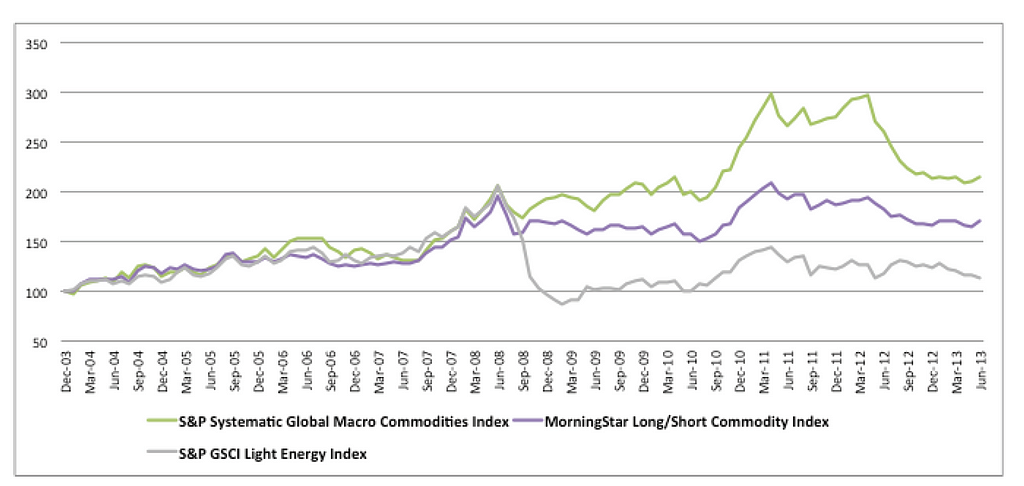 Performance of a Selection of Momentum Strategies
Performance of a Selection of Momentum Strategies
In general, their periods of underperformance do not always coincide with each other. They may offer the potential to diversify risk.
 Momentum Strategies — Historical Annualized Risk and Return
Momentum Strategies — Historical Annualized Risk and Return
The correlation between the strategies are low and that the correlation between these strategies and the broad index is low to negative. This is expected because commodities on an upward price trend automatically increase their representation in the broad index.
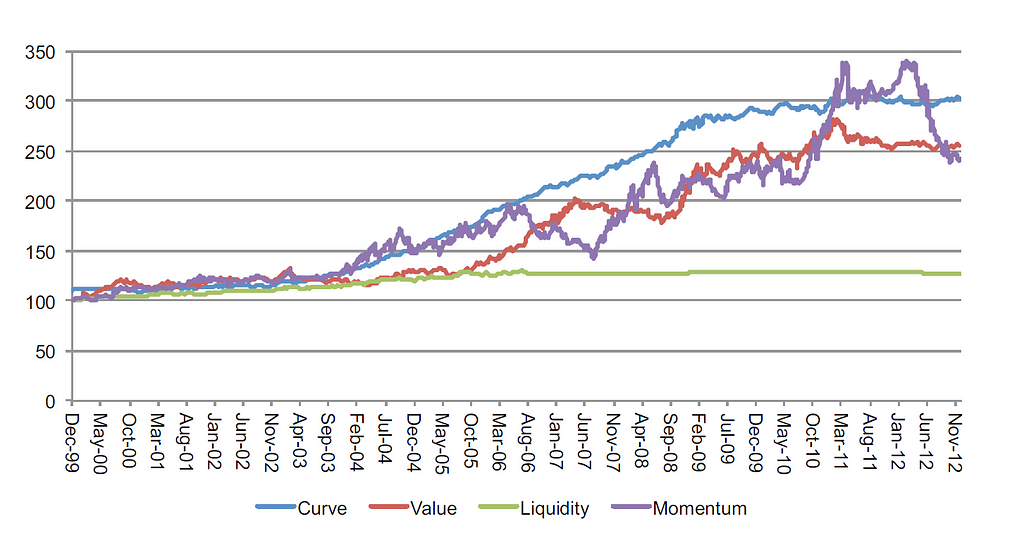 Historical Performance of Systematic Commodity Factors
Historical Performance of Systematic Commodity Factors
Historical Performance of Systematic Commodity Factors strategies allows commodities on a downward trend to be shorted, generating additional value for the strategies. Factor returns do not represent a source of riskless return. It is simply another way to construct an investment portfolio.
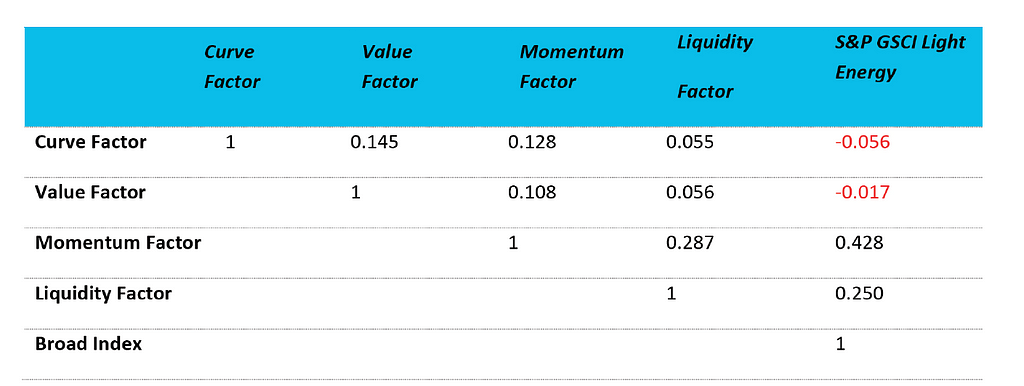 Correlation of Matrix of Commodity Risk Factors
Correlation of Matrix of Commodity Risk Factors
Figures on the left show that both strategies have outperformed the benchmark index on an absolute basis.
 Annualized Volatility and Maximum Drawdown of Commodity Risk Factors
Annualized Volatility and Maximum Drawdown of Commodity Risk Factors
However, the risk-weight has performed better overall because it has a lower level of risk, suggesting advantages in managing risks in creating a portfolio.
Overall, they both have a low correlation with the benchmark and act as a good portfolio diversifier.
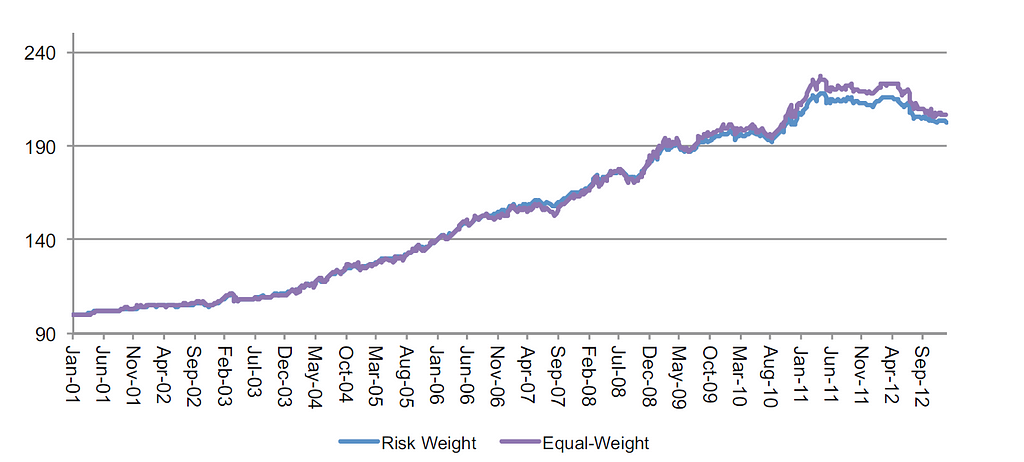 Historical Performance of Compromise Factor Strategies
Historical Performance of Compromise Factor Strategies
Source: S&P Dow Jones Indices. Data from Dec. 31, 1999 to Dec. 31, 2012. Charts are provided for illustrative purposes. Past
performance is not a guarantee of future results. Some data reflected in this chart may reflect hypothetical historical performance.
3. Conclusion
Alternative beta strategies can serve a variety of different investment objectives, including reducing volatility or reducing systematic risk exposures.
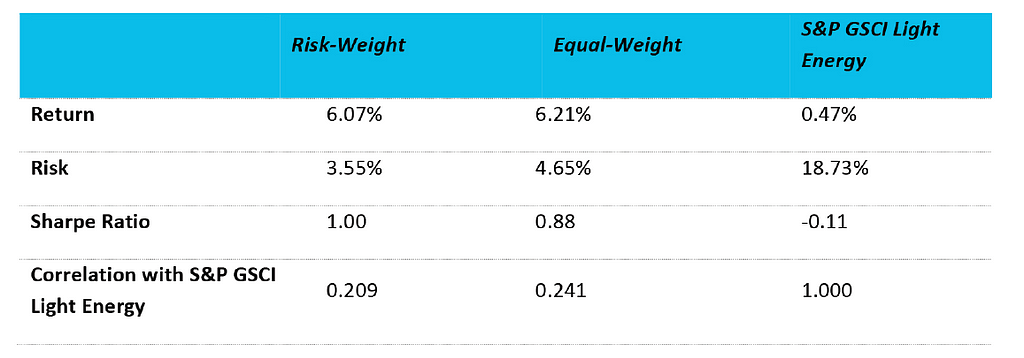 Composite Strategies Return: Historical Annualized Risk and Return
Composite Strategies Return: Historical Annualized Risk and Return
Investors must examine whether these strategies meet their objectives and risk-taking preferences.
Two main approaches to alternative beta are the ‘risk-based approach,’ reducing portfolio risk, and the ‘factor-based approach,’ which enhances return through earning systematic risk premia.
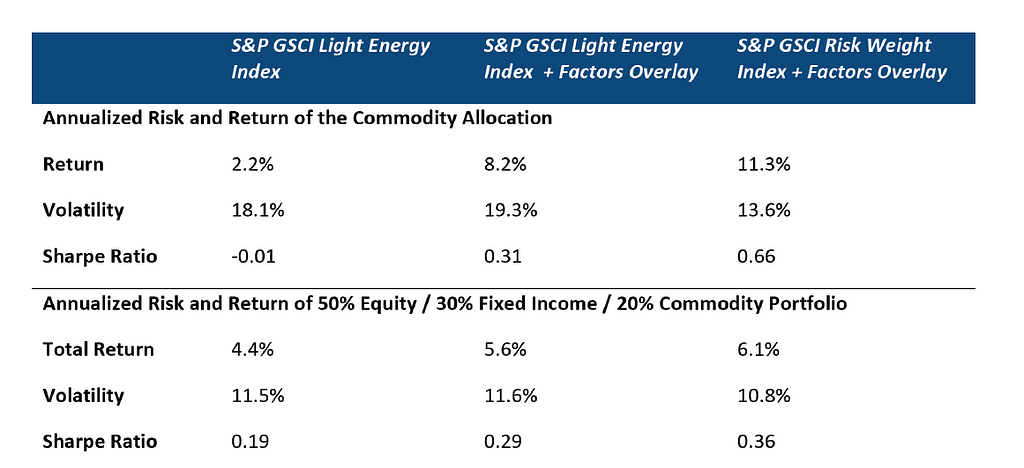 Combining Different Commodity Allocations in a Multi-Asset Portfolio
Combining Different Commodity Allocations in a Multi-Asset Portfolio
Whilst alternative beta is fairly well established in equity strategy investing, it is still a nascent concept in commodities.
However, as a result of investors’ pursuit of better-diversified portfolios and a recognition that systematic risk factors explain the majority of returns, the development of commodity alternative beta products is gathering pace.
There are potential benefits in allocating into alternative beta strategies as part of a portfolio’s commodity allocation and combining risk-based and factor-based commodity strategies have historically delivered a higher return and lower risk than passive long-only strategies on their own.
Finally, it should be borne in mind that alternative beta strategies often take substantial active risks, which are largely driven by factor exposures. Factor returns can be volatile, and all alternative beta strategies can experience considerable drawdown at times.
Disclaimer #1: This is not financial advice. I am not licensed to give financial advice nor do I intend to do so. This article is purely for information and learning purposes only.
Disclaimer #2: This article was adapted and rewritten from the original article from the Alternative Investment Analyst Review.
Follow Me and Decentralised Capital
Follow me to stay updated and learn new developments in financial markets and all things Blockchain.
Follow me on Twitter!
Alternative Beta Strategies in Commodities was originally published in Hacker Noon on Medium, where people are continuing the conversation by highlighting and responding to this story.
Disclaimer
The views and opinions expressed in this article are solely those of the authors and do not reflect the views of Bitcoin Insider. Every investment and trading move involves risk - this is especially true for cryptocurrencies given their volatility. We strongly advise our readers to conduct their own research when making a decision.
